
Paper Model
Leonardo da Vinci's Inventions
Author:
Lutz Pietschker
Version: 2010-12-31
Paper Modelling
|
Home Page
|
Links
|
What's New
General Information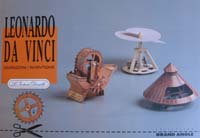
-
Title: Leonardo da Vinci Inventions
-
Publisher/Designer:
L'Instant Durable
-
Scale:
not given, approx. 1:150 ... 1:200
-
Size (built, l x w x h): 7x7x7 ... 15x15x10
-
No. of Sheets:
2 (A3)
This is a set of three small models showing three of Leonardo's "inventions" (if we may give that title to things that never were built, and never would have worked). Still, his was a very fertile mind that not only noticed (and annotated) the technical development of his time but that also was always thinking about the things that might come. The models are based on these sketches from da Vinci's notebooks:
 The models are typical L'Instant-style, i.e. good graphics and good-quality cardboard coupled with some curious (i.e. sometimes ingenious, sometimes just, well, curious...) construction techniques, but for an engineer like me the da Vinci models are a "must have built", of course. And to do them justice, these three are very neat constructions. Alas, they have one problem: They all rely on printing on the backside of the cardboard, and in my copy this was out of alignment with the front by up to 3mm. Which is a shame because the designs themselves are very precise, even the ship hull parts fit very neatly.
The models are typical L'Instant-style, i.e. good graphics and good-quality cardboard coupled with some curious (i.e. sometimes ingenious, sometimes just, well, curious...) construction techniques, but for an engineer like me the da Vinci models are a "must have built", of course. And to do them justice, these three are very neat constructions. Alas, they have one problem: They all rely on printing on the backside of the cardboard, and in my copy this was out of alignment with the front by up to 3mm. Which is a shame because the designs themselves are very precise, even the ship hull parts fit very neatly.
On the image to the left you can see the helicopter model, hovering in my workroom together with other pretty flyers.
Picture Gallery
(Click image to show it in large size in a new window.)
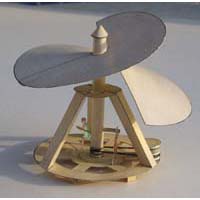
|
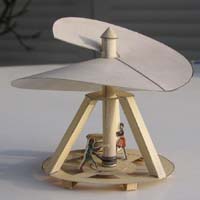
|
The helicopter is, of course, a pure fantasy of a time when the principle of flight was scarcely understood at all. Leonardo's idea obviously was that the flying machine would screw itself into the sky. It should be powered either by men driving the vertical "shaft" with capstan-like bars or, alternatively, by men pulling at a rope wound round a transmission drum, the drum in turn driving the shaft through a set of transmission ropes.
|
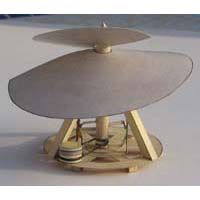
|
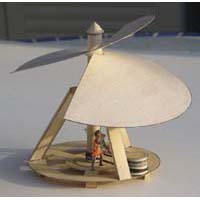
|
As you can see, the model combines both principles into one model (as did Leonardo's original drawing), thereby presumably causing the men stumbling over the transmission ropes with every turn of the "capstan".
|

|
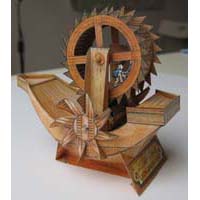
|
Stern and half-profile view. The ship's hull resembles the typical ships of that time, often Columbus' ships are shown with very similar hull forms with fore and back castles. The ship comes with a detachable cradle.
|
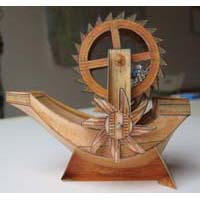
|

|
Here you can see the mechanical principle of the ship's propulsion system: Men walk in a treadmill wheel, and its rotation is transmitted to the paddlewheels by a simple (probably wooden) cogwheel.
The treadmill whell and the smaller cogwheel actually comb and move together in the model, even if movement is a bit uneven.
|
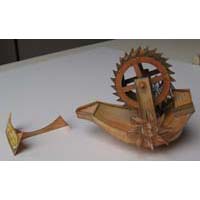
|
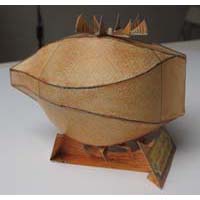
|
Here you see the detached cradle and the ship's sturdy little hull from the underside. The model is beautifully designed and fitted excellently.
|
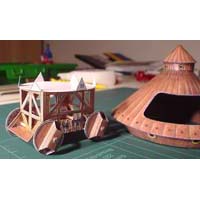
|
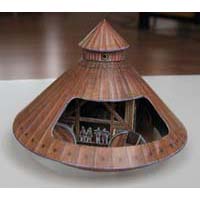
|
The armoured car shown before the final assembly, allowing a look at the detailed interior most of which will be hidden inside the armour afterwards. However, the armour shell of the model has a peek-hole to see some of the propulsion mechanism as envisaged by Leonardo.
The upper turret and the lower armour ring were supposed to house guns, but neither the gun nor any possible mounting platform is shown in the model.
|
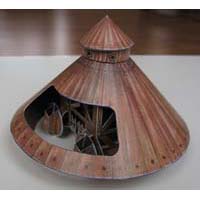
|
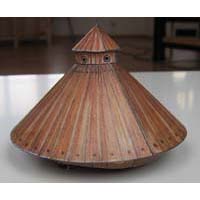
|
A view from another angle, and at the closed armour shell- this is how the enemy would have seen the machine.
|
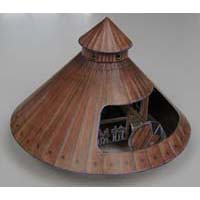
|
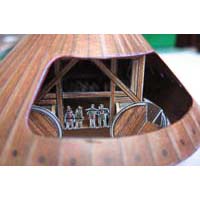
|
Another look into the interior. Men moving crank were supposed to move the car by a simple and direct cogwheel system. The close-up shows the very fine details of the model. The men driving the cranks are about 8 mm large in the model.
|
As the author of this page I take no expressed or implied responsibility for the content of external links; opinions expressed on such pages are not necessarily mine. The web space provider is not responsible for the contents of this page or any linked pages.


Written and published by Lutz Pietschker. Please send comments about technical problems to the
site master.
-Made with a Mac!-
, last change
2011-03-12



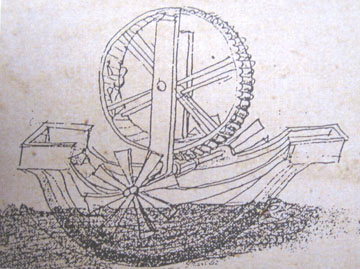
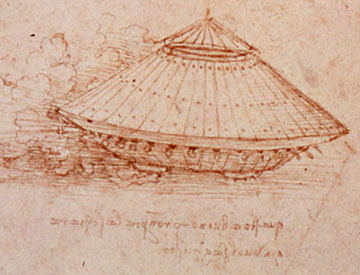
 The models are typical L'Instant-style, i.e. good graphics and good-quality cardboard coupled with some curious (i.e. sometimes ingenious, sometimes just, well, curious...) construction techniques, but for an engineer like me the da Vinci models are a "must have built", of course. And to do them justice, these three are very neat constructions. Alas, they have one problem: They all rely on printing on the backside of the cardboard, and in my copy this was out of alignment with the front by up to 3mm. Which is a shame because the designs themselves are very precise, even the ship hull parts fit very neatly.
The models are typical L'Instant-style, i.e. good graphics and good-quality cardboard coupled with some curious (i.e. sometimes ingenious, sometimes just, well, curious...) construction techniques, but for an engineer like me the da Vinci models are a "must have built", of course. And to do them justice, these three are very neat constructions. Alas, they have one problem: They all rely on printing on the backside of the cardboard, and in my copy this was out of alignment with the front by up to 3mm. Which is a shame because the designs themselves are very precise, even the ship hull parts fit very neatly.